The Best Non Toxic Tents Without Flame Retardants
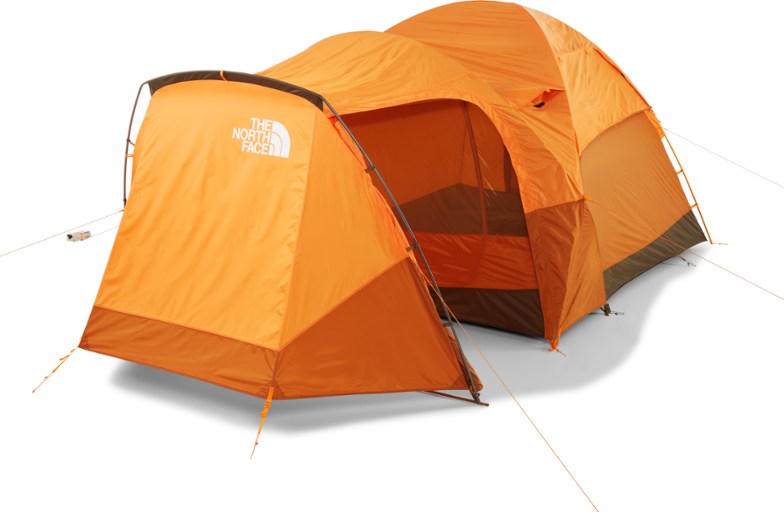
When it comes to camping, choosing the right tent isn’t just about comfort—it’s also about keeping chemicals out of your environment! After all, the getting closer to nature is supposed to be a healthy experience, right?
What’s a Non Toxic Tent?
Have you ever purchased a new tent and smelled a faintly chemical odor? This is known as off-gassing and means that chemicals used to treat different parts of the tent are being slowly released into the air and the environment.
The traditional coating used in tents to make them flame resistant and waterproof often include polyurethane, durable water repellents (DWRs), and fire retardants, which contain per- and polyfluoroalkyl substances (PFAS) and volatile organic compounds (VOCs).
A non toxic tent is made with as few of these chemicals as possible. This is done to reduce harmful substances that are released into the air and surrounding environment. This also reduces the impact of off-gassing and improves air quality inside the tent.

Why Choose a Non Toxic Tent?
The chemicals present in non-toxic tents can pose risks to humans, animals and the environment. We spoke with Daniela Rodriguez at ConsumerNotice.org, who provided the following information:
“Traditional tents often utilize a coating of polyurethane combined with a layer of harmful synthetic chemicals known as ‘durable water repellents’ (DWRs), which are derived from per and polyfluoroalkyl substances.
These PFAS, often referred to as ‘forever chemicals,’ are prevalent in numerous consumer goods but pose significant toxicity concerns.
They exhibit persistence in both the environment and our bodies, elevating the potential for adverse health effects such as liver damage, thyroid disorders, fertility issues, and an increased risk of cancer.”
For these reasons, opting for a non toxic tent made without, or with minimal, chemical additives reduces exposure to forever chemicals, and helps to keep these substances out of the natural environment.
What to Look for in a Non Toxic Tent
Here’s a checklist of key features to look for when shopping for a non toxic tent:
- Flame Retardant-Free: Non toxic tents must be made without flame retardant chemicals and VOCs. Brands like Fjallraven, NEMO, Big Agnes and REI are committed to making tents without FR chemicals.
- Eco-Friendly Dyes: Look for tents made with natural, water based or low-impact dyes.
- Chemical-Free Fabrics: Make sure the tent fabrics are made with certified non toxic fabrics, free of VOCs, PFAs, and PFCs. This will reduce off-gassing and exposure to potentially harmful chemicals.
- DAC Tent Poles. Look for tents that have DAC poles, made from aluminum alloy. These poles are made without toxic chemicals like phosphoric and nitric acid.
- Silicone-Based Waterproofing: Silicone-based waterproofing is less toxic than polyethylene (PU) coatings, which contain VOCs. If you need to treat your tent, use eco-friendly waterproofing sprays like Hawk Tools Canvas Waterproofer or DryGuy Tent Waterproofing.
- Eco Friendly Certifications: Look for labels that verify the tent is made with eco-friendly materials and manufacturing practices. These include bluesign®, OEKO-TEX, Global Organic Textile Standard (GOTS), and Global Organic Latex Standard (GOLS).
The Best Non-Toxic Camping Tents
The eco friendly tents in our list range from 2-person tents to 6-person tents. All of the tents are made without flame retardants, however, some of the tents do include waterproofing chemicals and dyes.
The North Face Stormbreak

| Preview | Product | Price | |
|---|---|---|---|
| | THE NORTH FACE Stormbreak 3 Three-Person Camping Tent, Golden Oak/Pavement, One Size | $220.00 | Buy on Amazon |
The North Face Stormbreak is a 3-person, 4-season tent that’s known for its durability, enhanced waterproofing, quick pitch, and relative lightweight design for a tent of this capacity.
| FEATURES |
| Design: Freestanding |
| Capacity: 3 person |
| Seasons: 4 |
| Doors / Vestibules: 2 |
| Poles: 2 (Easy setup in under 10 min.) |
| Minimum Trail Weight: 5 lbs. 5 oz. |
| Packed Size: 8″ X 22″ (20.3cm X 55.9cm) |
| Floor Dimensions: 88 x 65 inches |
| Vestibule Area: 10.8 + 10.8 square feet |
| Material: 75-denier polyester with 1,200 mm waterproof rating |
Big Agnes Bunk House 6P
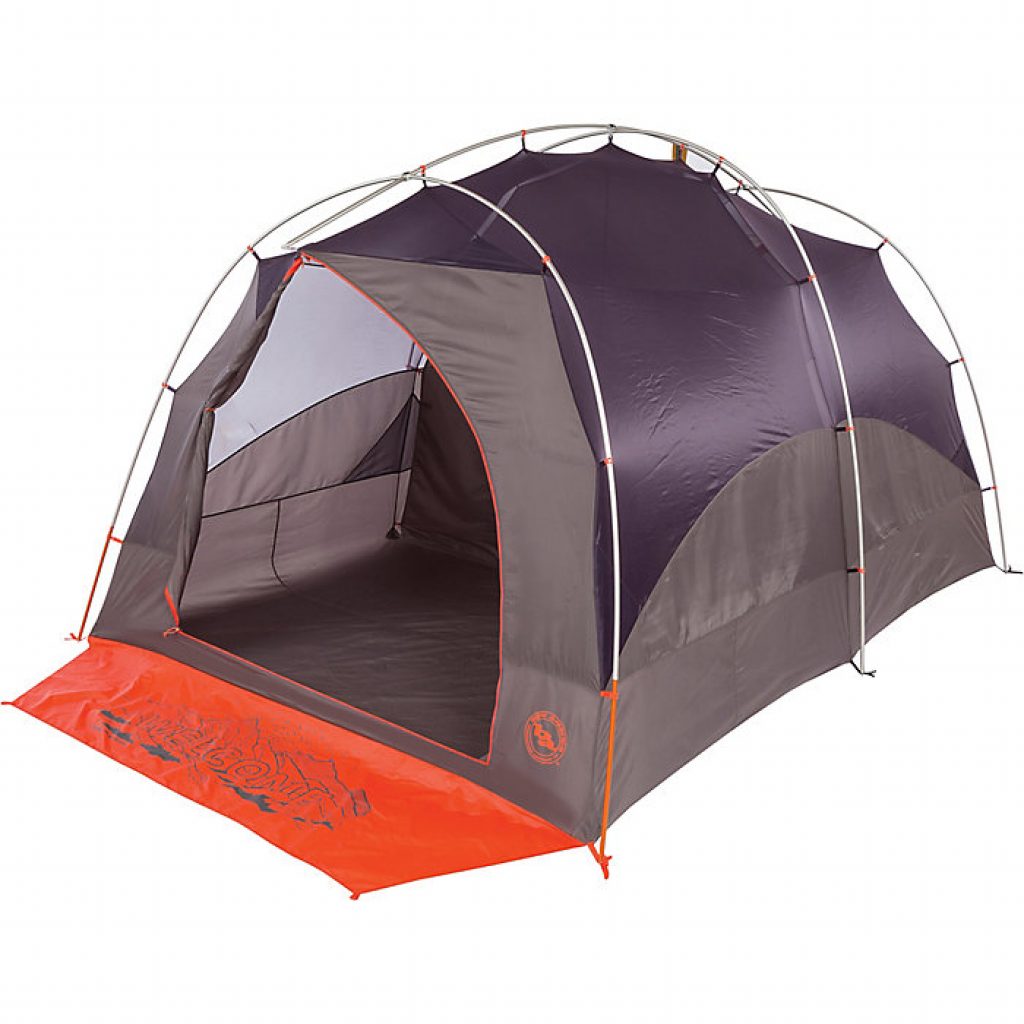
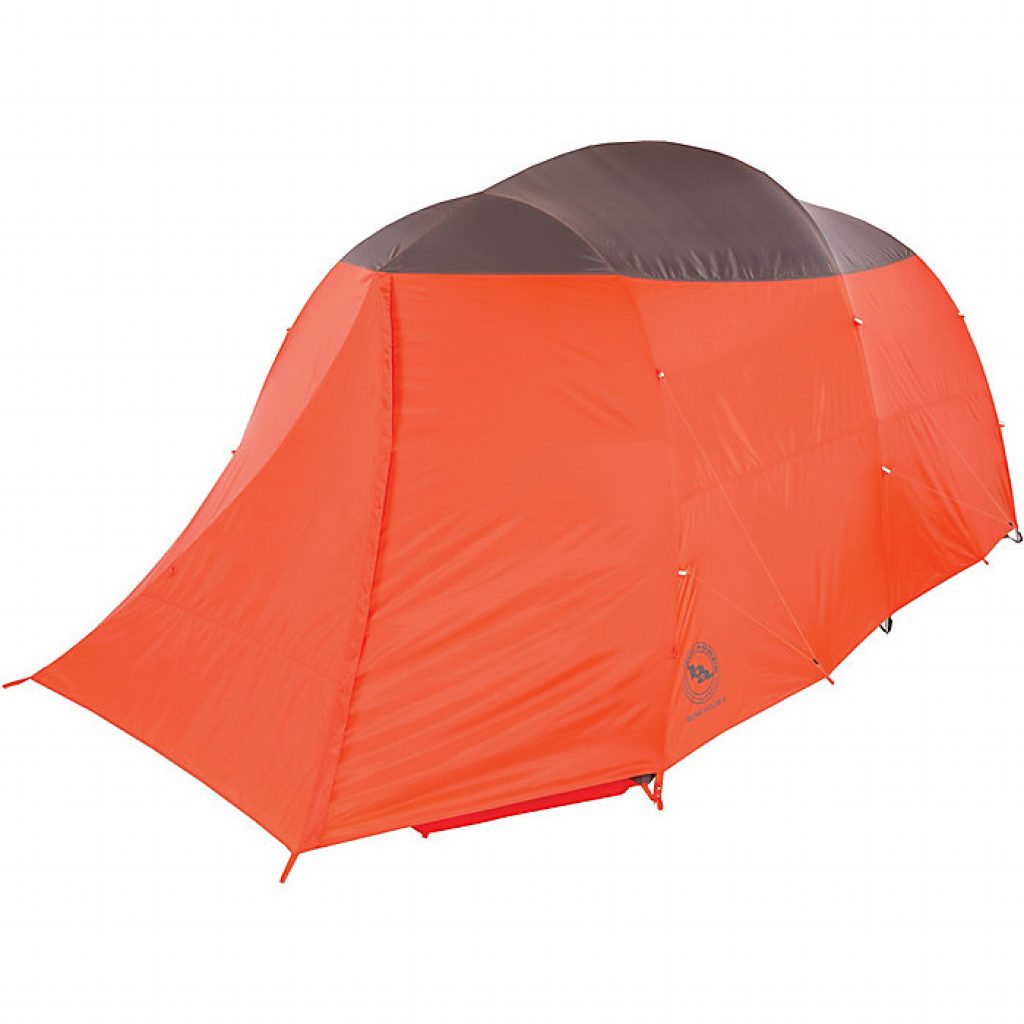
| Preview | Product | Price | |
|---|---|---|---|
| | Big Agnes Bunk House Camping Tent, 6 Person | $449.95 | Buy on Amazon |
The Big Agnes Bunk House 6P is a spacious family tent with front vestibule and shelter mode. High-quality materials, easy setup. Stay dry and organized with ample storage options.
| FEATURES |
| Design: Freestanding |
| Capacity: 6 person |
| Seasons: 3 |
| Doors / Vestibules: 2 |
| Poles: 2 (Easy setup in under 10 min.) |
| Minimum Trail Weight: 18 lbs. 6 oz. |
| Packed Size: 27.5 x 17 x 7.5 inches |
| Floor Dimensions: 118 L x 100 W x 78 H inches |
| Vestibule Area: 56 square feet |
| Material: 1500 mm polyester taffeta |
North Face Wawona 6
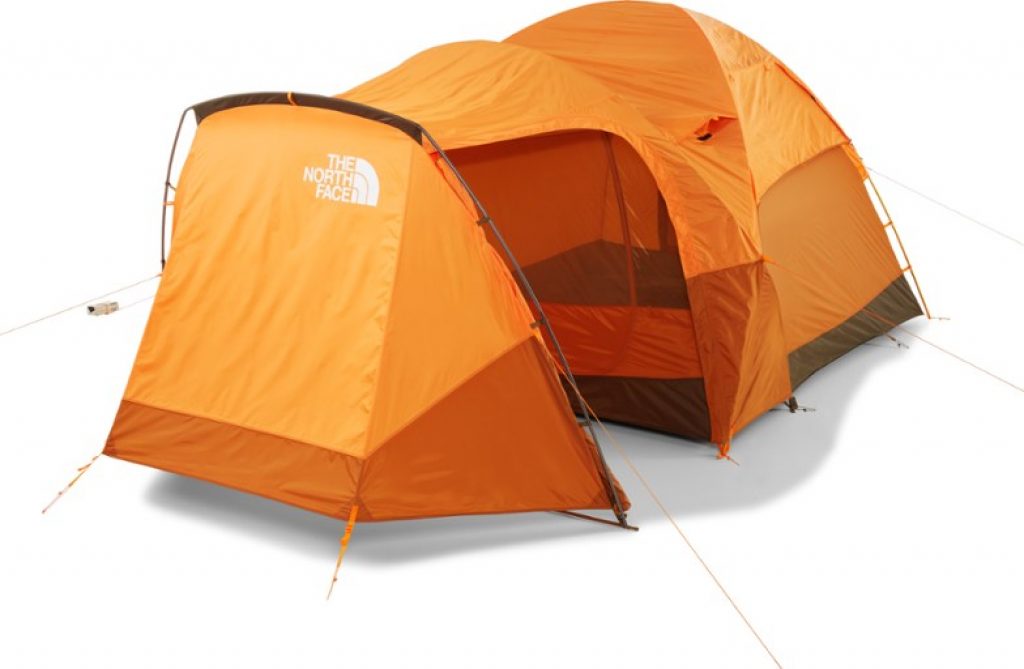
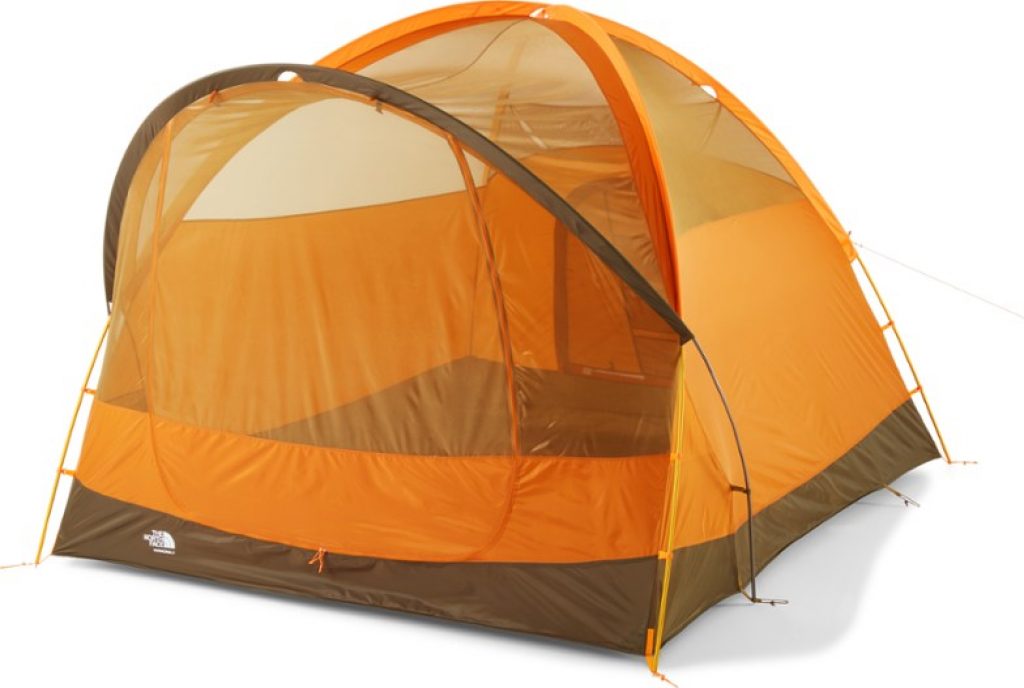
| Preview | Product | Price | |
|---|---|---|---|
| | The North Face Wawona 6 Six-Person Camping Tent – (No Flame-Retardant Coating), Light Exuberance... | $495.00 | Buy on Amazon |
The North Face Wawona 6 is one of the best family tents on the market, with a double-wall design, generous interior space, great ventilation and extra storage space, it feels more like a house than a tent.
| FEATURES |
| Design: Freestanding |
| Capacity: 6 Person |
| Seasons: 3 |
| Doors / Vestibules: 2 |
| Poles: 4 (Mediume setup in 15-20 minutes) |
| Weight: 20 pounds (9.07 kilograms) |
| Dimensions: 120 W x 96 H x 78 H inches |
| Vestibule Area: 44.7 square feet (4.15 square meters) |
| Material: Polyester |
NEMO Aurora Highrise
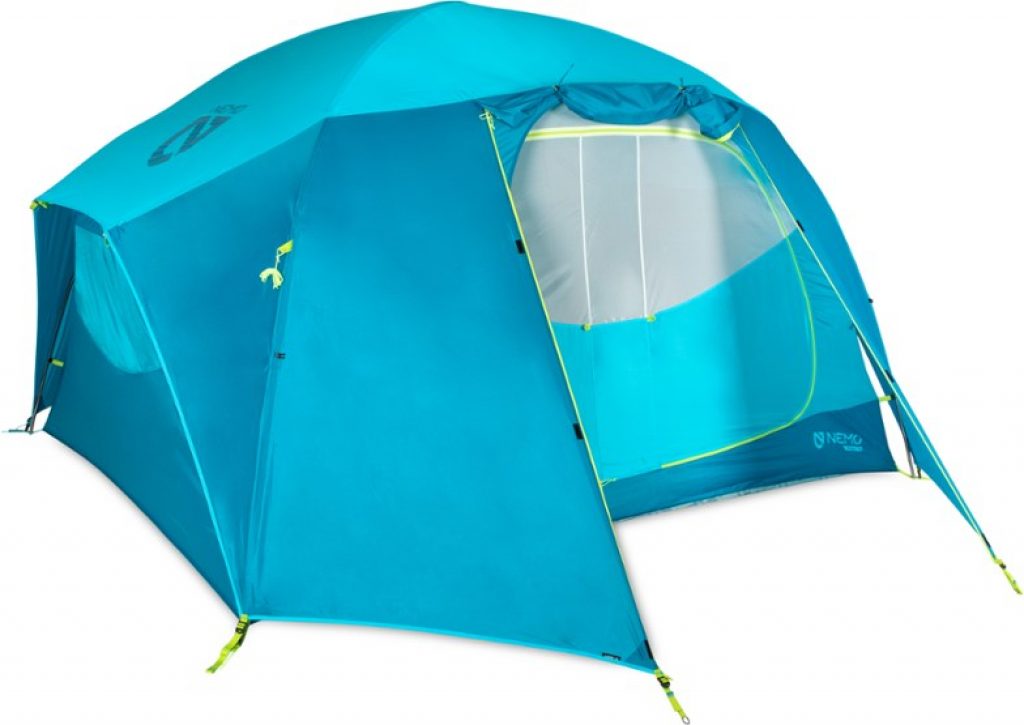
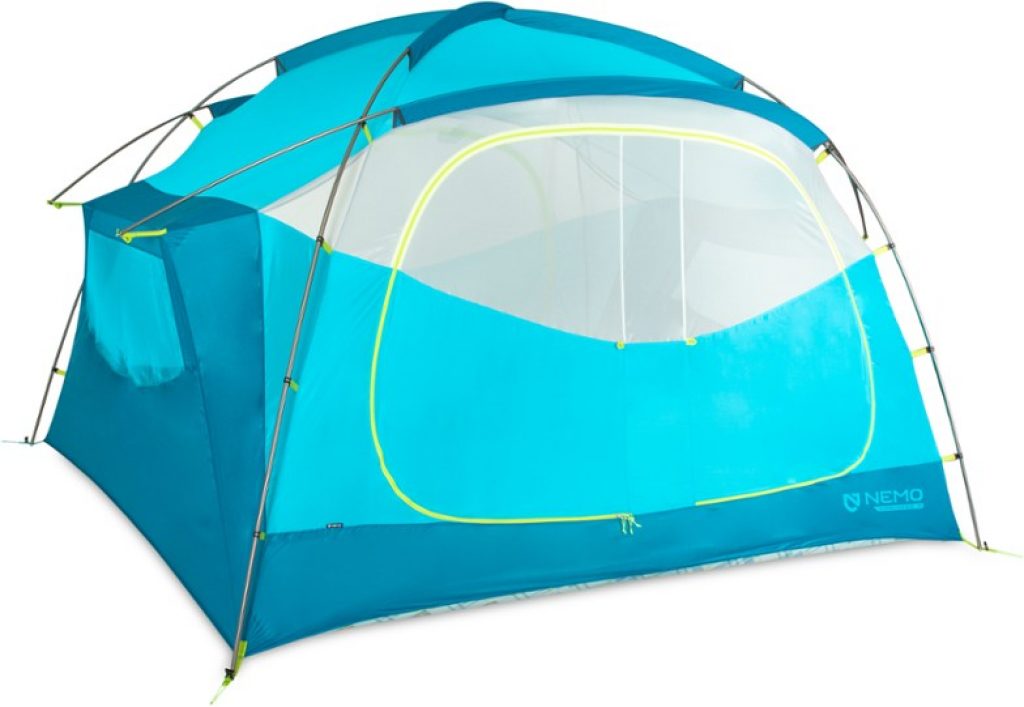
| Preview | Product | Price | |
|---|---|---|---|
| | Nemo Aurora Highrise, 3 Season, Family, Car Camping Tent, Atoll/Oasis, 6P | $499.95 | Buy on Amazon |
The NEMO Aurora 6P has a large, comfortable living space, with extra headspace for upright standing, and large, protected side windows for great ventilation and beautiful views of nature.
| FEATURES |
| Capacity: 6 person |
| Seasons: 3 |
| Weight: 18 pounds, 14 ounces |
| Doors / Vestibules: 2 |
| Peak Height: 6.1 feet |
| Floor Dimensions: 120 x 100 inches (305 x 254 centimeters) |
| Material: Polyester |
Alpkit Roundhouse Organic Cotton Canvas Tent
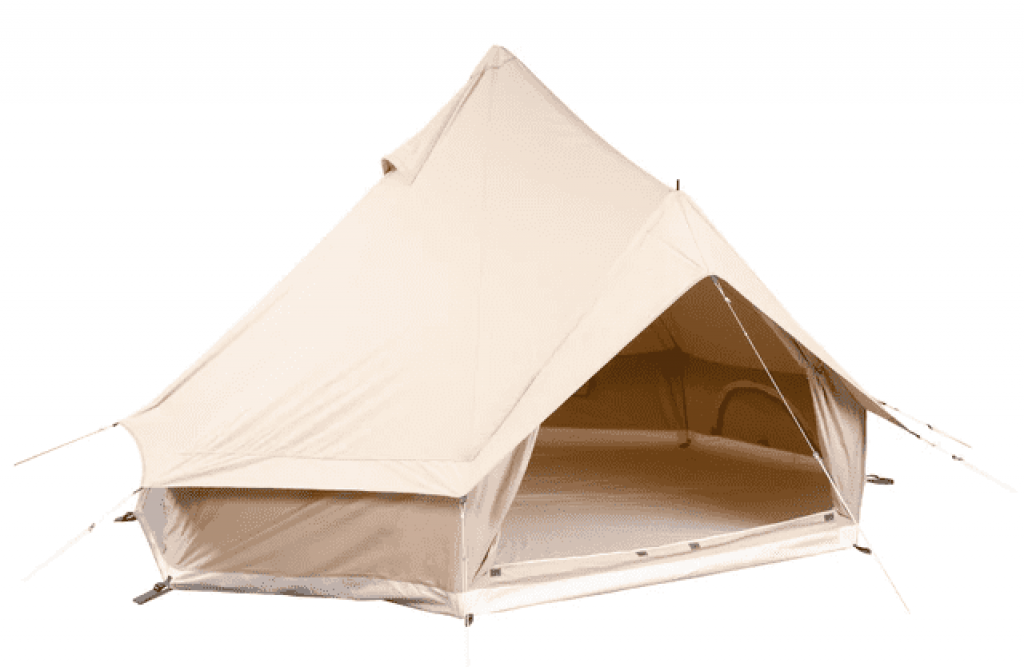
The Roundhouse has a luxurious, spacious environment that feels like a permanent structure, with an organic poly-cotton shell that significantly improves air quality and ventilation inside the tent.
| FEATURES |
| Capacity: 6 person |
| Seasons: 3 |
| Weight: 26.94 pounds (12.21 kilograms) |
| Doors / Vestibules: 2 |
| Peak Height: 9.84 feet (299.9 centimeters) |
| Floor Area: 6.56 feet diameter (199.9 centimeters) |
| Material: 65% polyester and 35% organic cotton eco friendly materials |
2/3 Person Camping Tents, Ideal for Couples, Backpacking and Car Camping
Big Agnes Copper Spur HV UL3
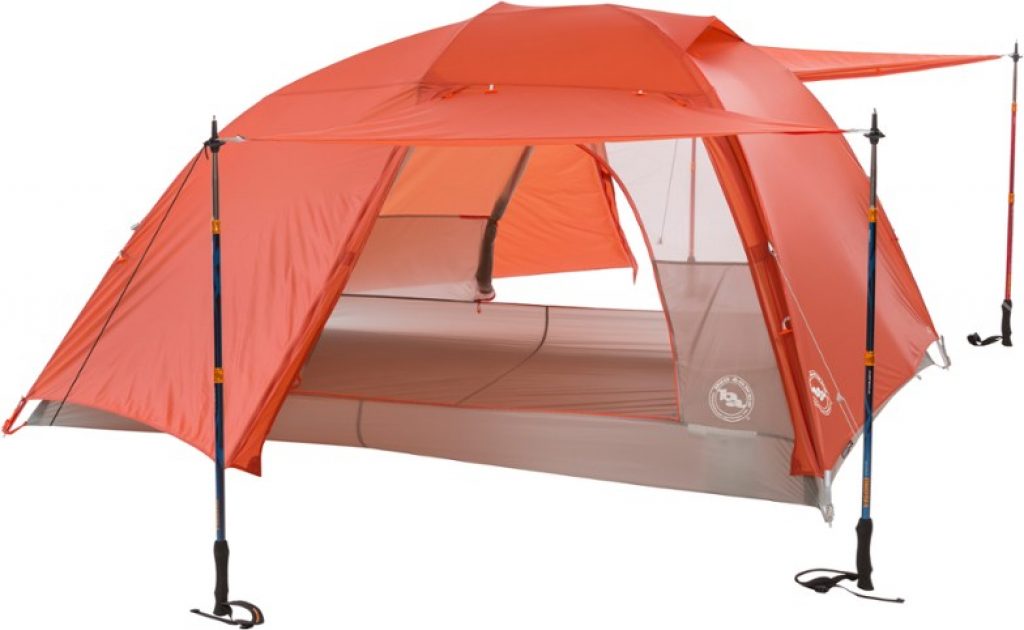
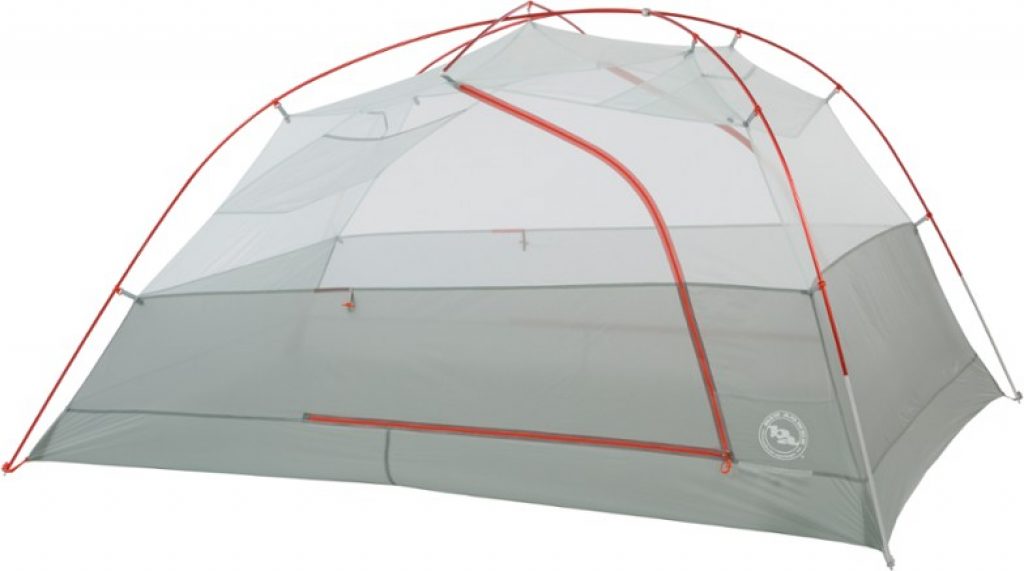
| Preview | Product | Price | |
|---|---|---|---|
| | Big Agnes Copper Spur HV UL Backpacking Tent, 2 Person (Orange) | $476.00 | Buy on Amazon |
The Big Agnes Copper Spur is ultralight, sturdy, and waterproof, with generous livable space and tons of storage compartments.
| FEATURES |
| Design: Freestanding |
| Capacity: 3 person |
| Seasons: 3 |
| Doors / Vestibules: 2 |
| Poles: 2 (Easy setup in under 10 min.) |
| Minimum Trail Weight: 3 pounds, 8 ounces (~1.5 kilograms) |
| Packed Size: 21 x 6 inches (53.34 x 15.24 centimeters) |
| Floor Dimensions: 90 x 70 inches (228.6 x 177.8 centimeters) |
| Vestibule Area: 33 square feet (3 square meters) |
| Peak Height: 43 inches (109.22 centimeters) |
| Material: Ripstop nylon |
NEMO Dagger OSMO
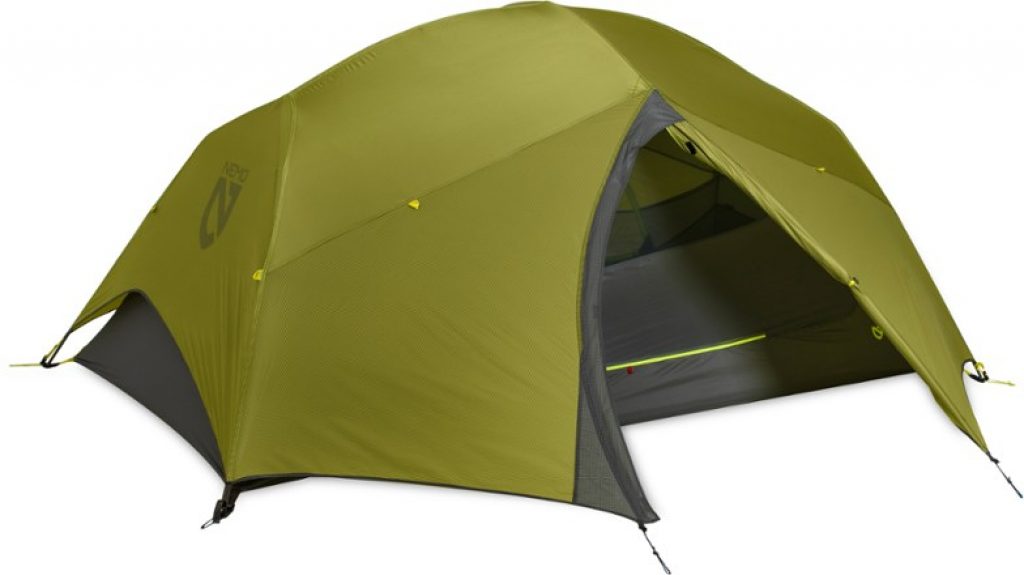
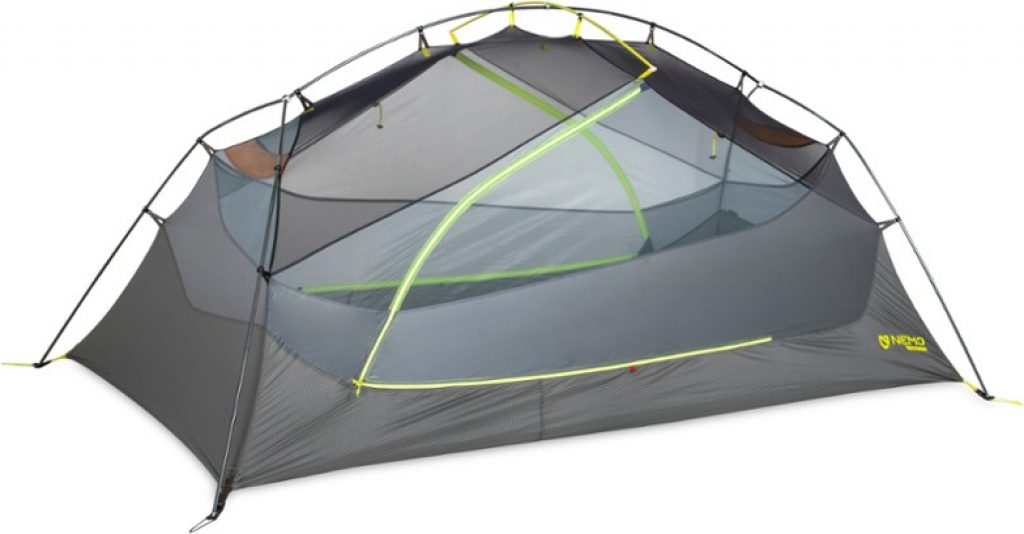
| Preview | Product | Price | |
|---|---|---|---|
| | Nemo Dagger OSMO Ultralight Backpacking Tent, Birch Bud/Goodnight Gray, 2 Person | $479.00 | Buy on Amazon |
The NEMO Dagger OSMO’s spacious design and superior ventilation make it pleasantly livable and well-suited for long excursions.
| FEATURES |
| Design: Freestanding |
| Capacity: 2 person |
| Seasons: 3 |
| Doors / Vestibules: 2 |
| Poles: 1 (Easy setup in less than 10 minutes) |
| Minimum Trail Weight: 3 pounds, 6 ounces (~1.3 kilograms) |
| Floor Dimensions: 90 x 50 inches (228.6 x 127 centimeters) |
| Floor Area: 31.3 square feet (2.9 square feet) |
| Vestibule Area: 11.4 + 11.4 square feet (1.02 + 1.02 square meters) |
| Peak Height: 42 inches (106.68 centimeters) |
| Material: Ripstop nylon |
Mountain Hardwear Mineral King 2 Tent

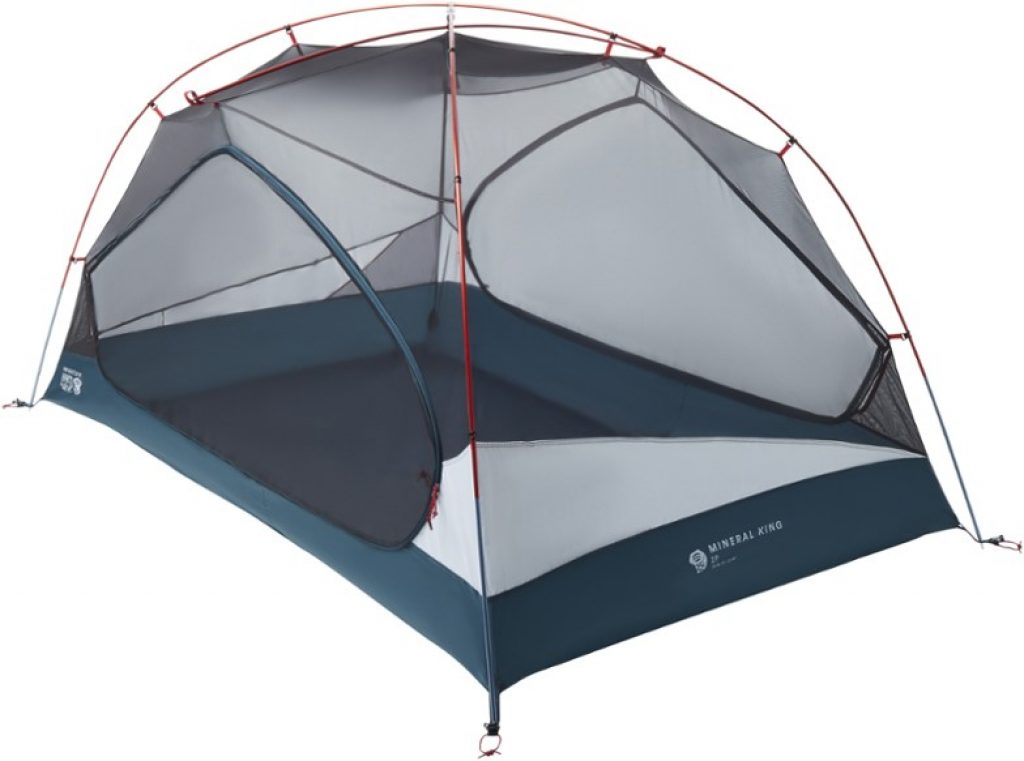
| Preview | Product | Price | |
|---|---|---|---|
| | Mountain Hardwear 1886251063O/S Mineral King 2 Tent Grey Ice O/S | $325.00 | Buy on Amazon |
The Mountain Hardwear Mineral King 2 is budget-friendly tent lightweight enough for short backpacking trips, and spacious enough for longer excursions.
| FEATURES |
| Design: Freestanding |
| Capacity: 2 person |
| Seasons: 3 |
| Doors / Vestibules: 2 |
| Poles: 2 (Easy setup in less than 10 min.) |
| Minimum Trail Weight: 6 pounds |
| Floor Dimensions: 88 x 54 inches (223.52 x 137.16 centimeters) |
| Vestibule Area: 18.3 square feet (1.7 square meters) |
| Peak Height: 43 inches (109.22 centimeters) |
| Material: Polyester |
REI Co-Op Half Dome Tent
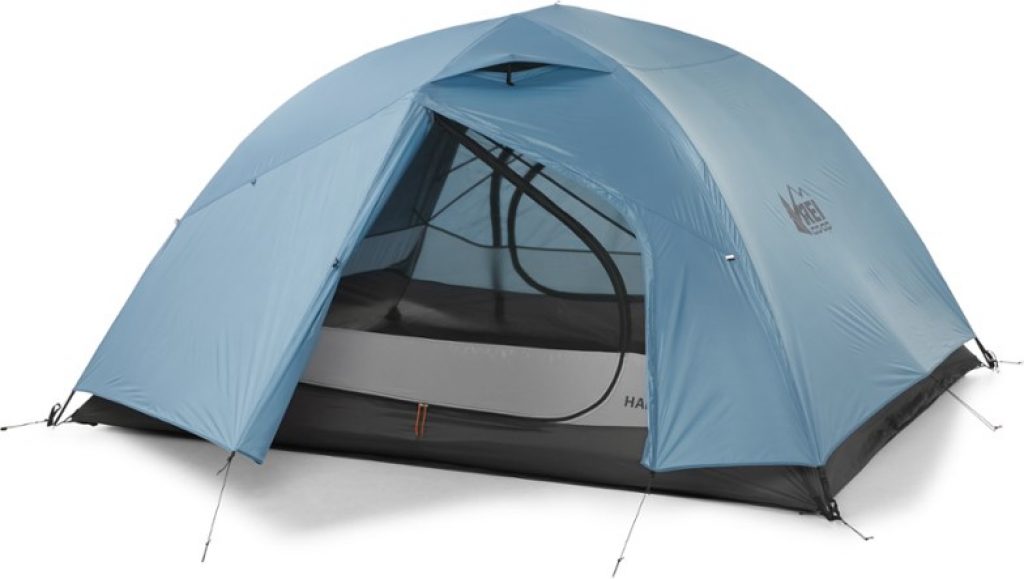
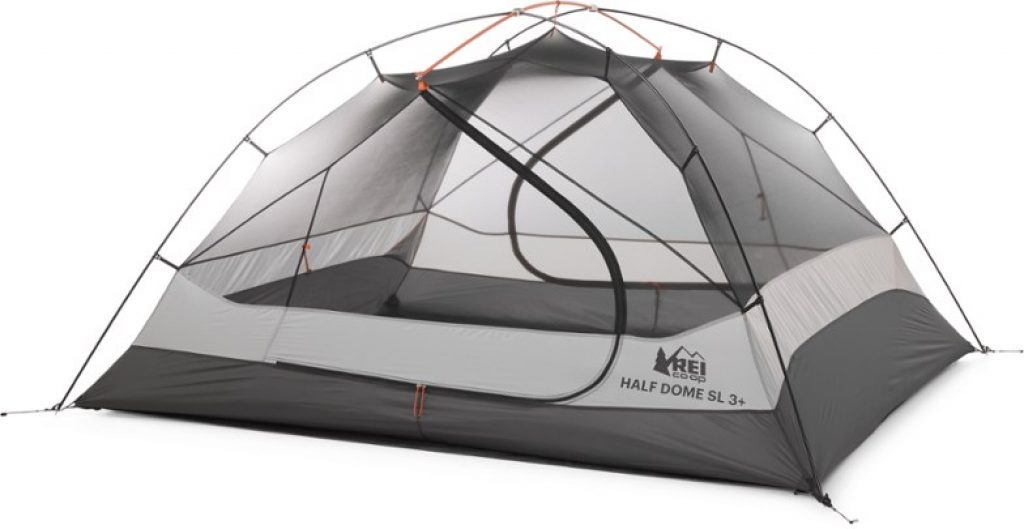
The REI Half-Dome backpacking tent is a best-in-class product that checks all the boxes – it’s lightweight with large interior space, superior ventilation and plenty of storage.
| FEATURES |
| Design: Freestanding |
| Capacity: 3 Person |
| Seasons: 3 |
| Doors / Vestibule: 2 |
| Poles: 1 |
| Weight: 4 pounds, 13 ounces (~2.1 kilograms) |
| Peak Height: 44 inches (112 centimeters) |
| Floor Dimensions: 90 x 78 inches (227 x 198 centimeters) |
| Vestibule Dimensions: 22.5 square feet (2 square meters) |
| Material: Nylon |
Hyperlite Mountain Gear UltaMid
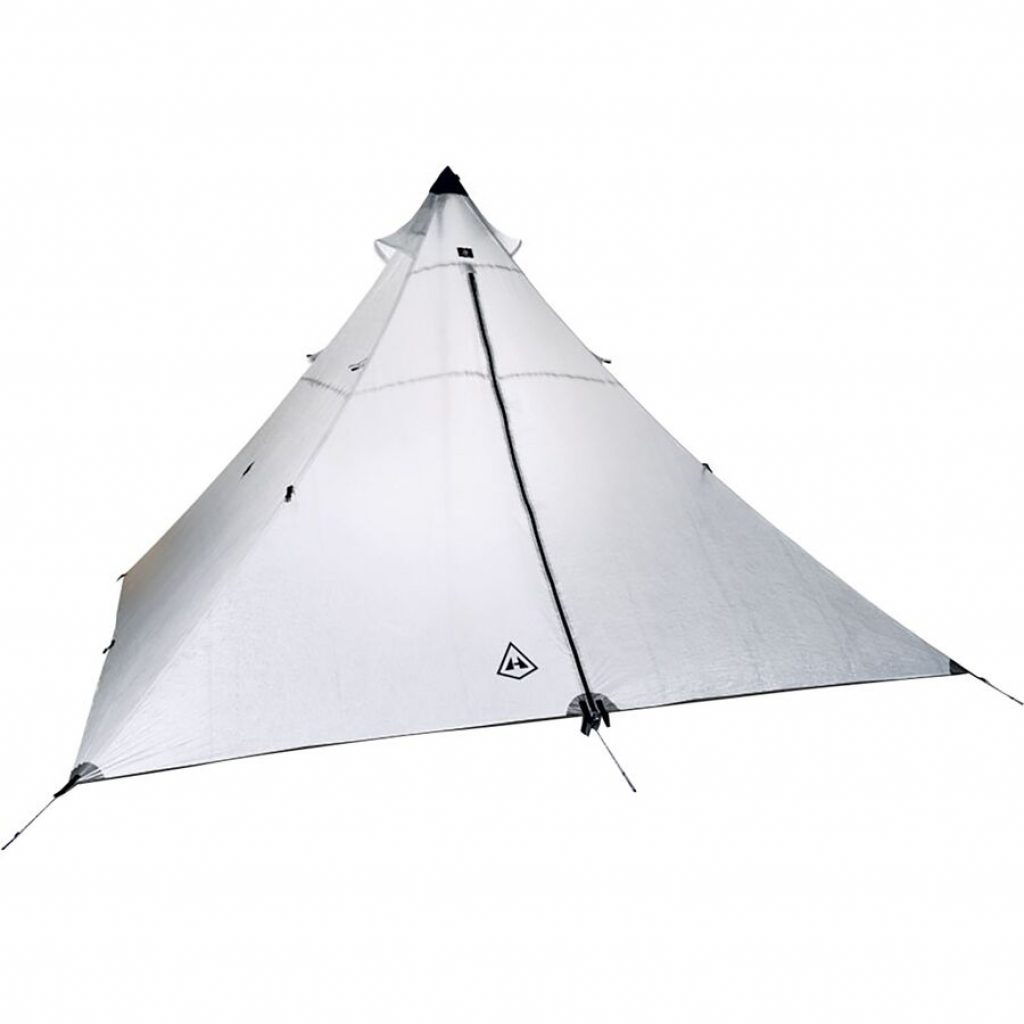
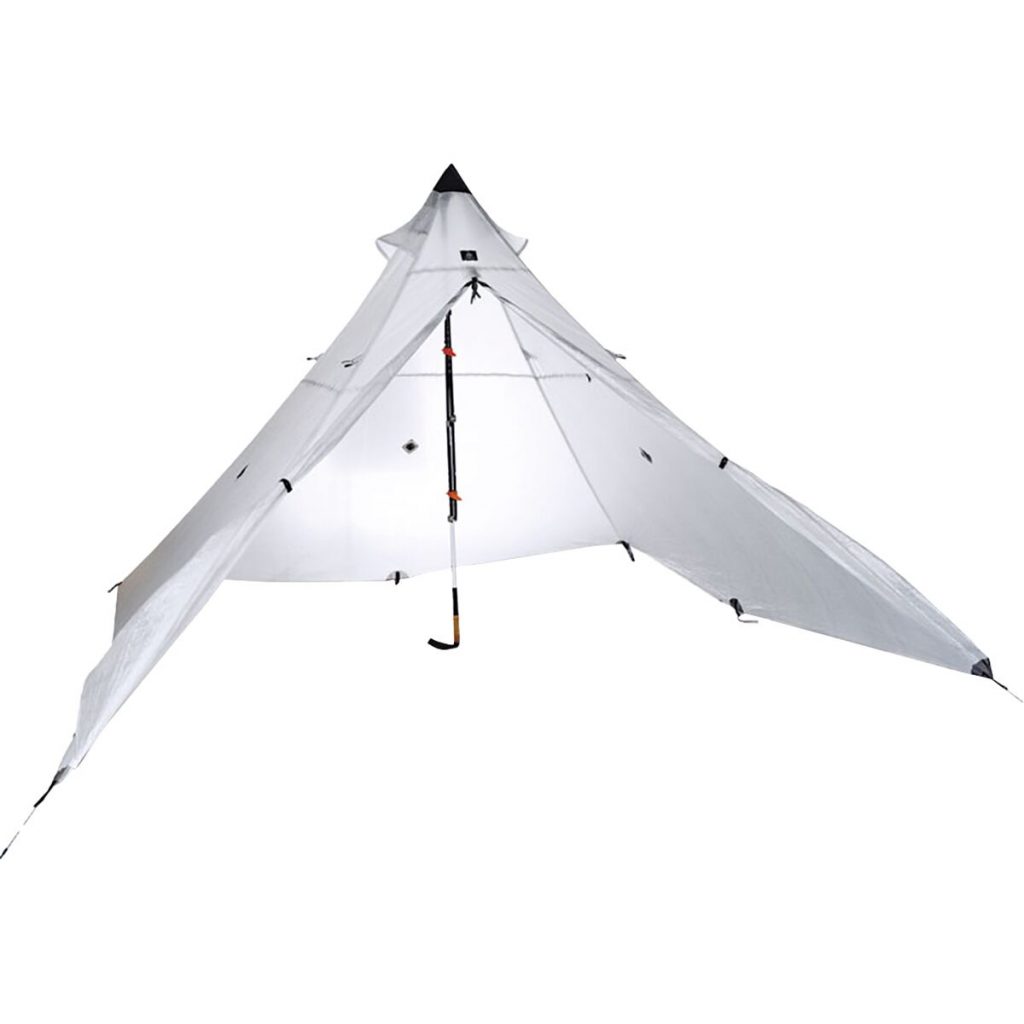
The Hyperlite UltraMid is one of the lightest backpacking tents, at only 1.7 pounds, with a shell made from 100% waterproof Dyneema® composite fabric, a fabric that is stronger and longer lasting that carbon fiber.
| FEATURES |
| Capacity: 2 person |
| Seasons: 3 |
| Doors / Vestibule: 1 |
| Poles: 1 |
| Weight: 1 pound, 7.7 ounces |
| Peak Height: 5 feet, 4 inches |
| Floor Dimensions: 83 x 107 inches (211 x 272 centimeters) |
| Material: Dyneema Composite Fiber (DCF) fabric |
Alpkit Tetri
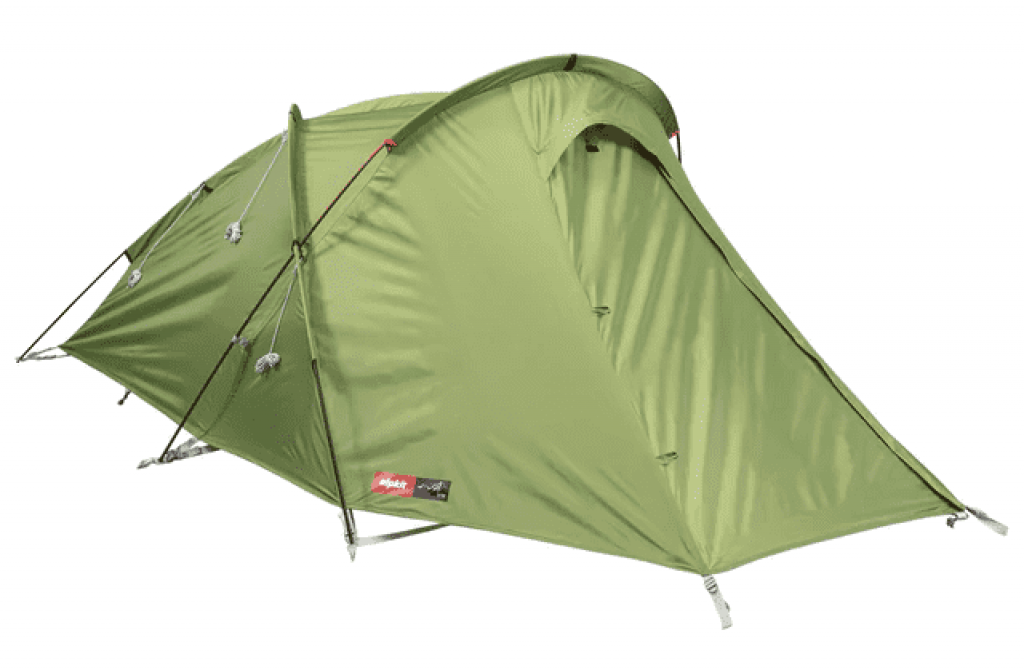
The Alpkit Tetri’s unique geodesic, three-pole design make it sturdy and well-equipped for all types of weather.
| FEATURES |
| Capacity: 2 person |
| Seasons: 3 |
| Doors / Vestibules: 1 |
| Weight: 6.6 pounds (3 kilograms) |
| Floor Dimensions: 126 x 58 x 43 inches (320 x 149 x 110 centimeters) (L x W x H) |
| Material: Polyester |
Lucky Sheep
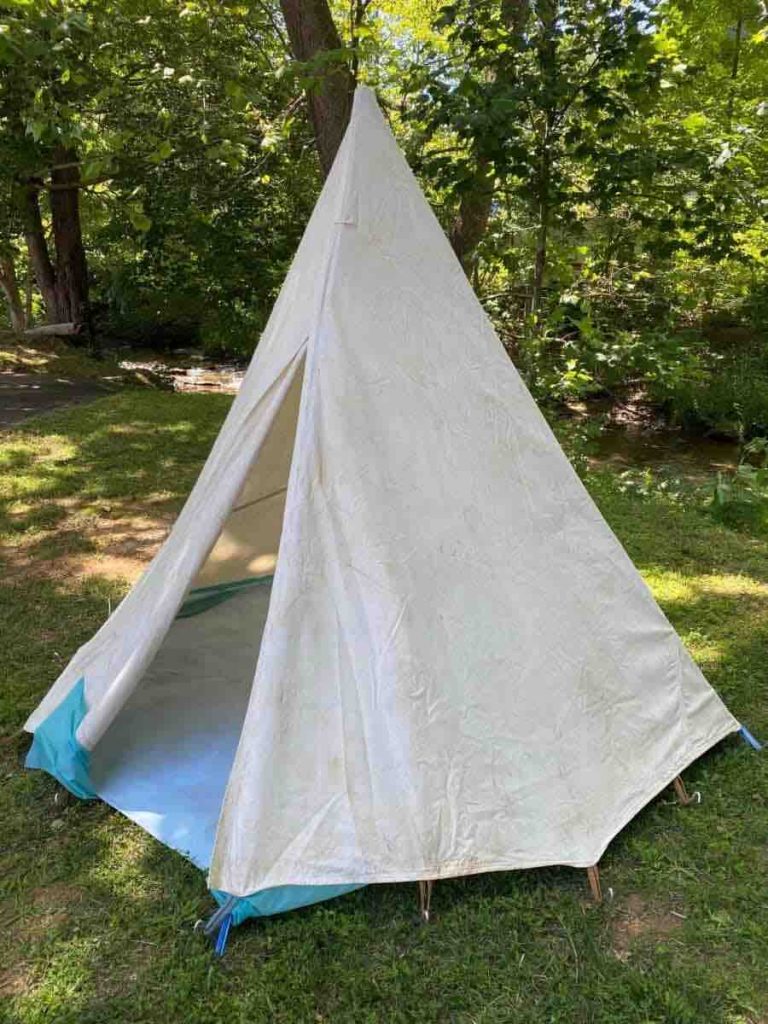
Lucky Sheep’s organic cotton canvas tent harkens back to old school tents of yore, with breathable, non-toxic fabric coated with beeswax for waterproofing.
| FEATURES |
| Capacity: 2 person |
| Seasons: 3 |
| Doors / Vestibules: 1 |
| Weight: 6.6 pounds (3 kilograms) |
| Floor Dimensions: 10 foot diameter |
| Material: Polyester |
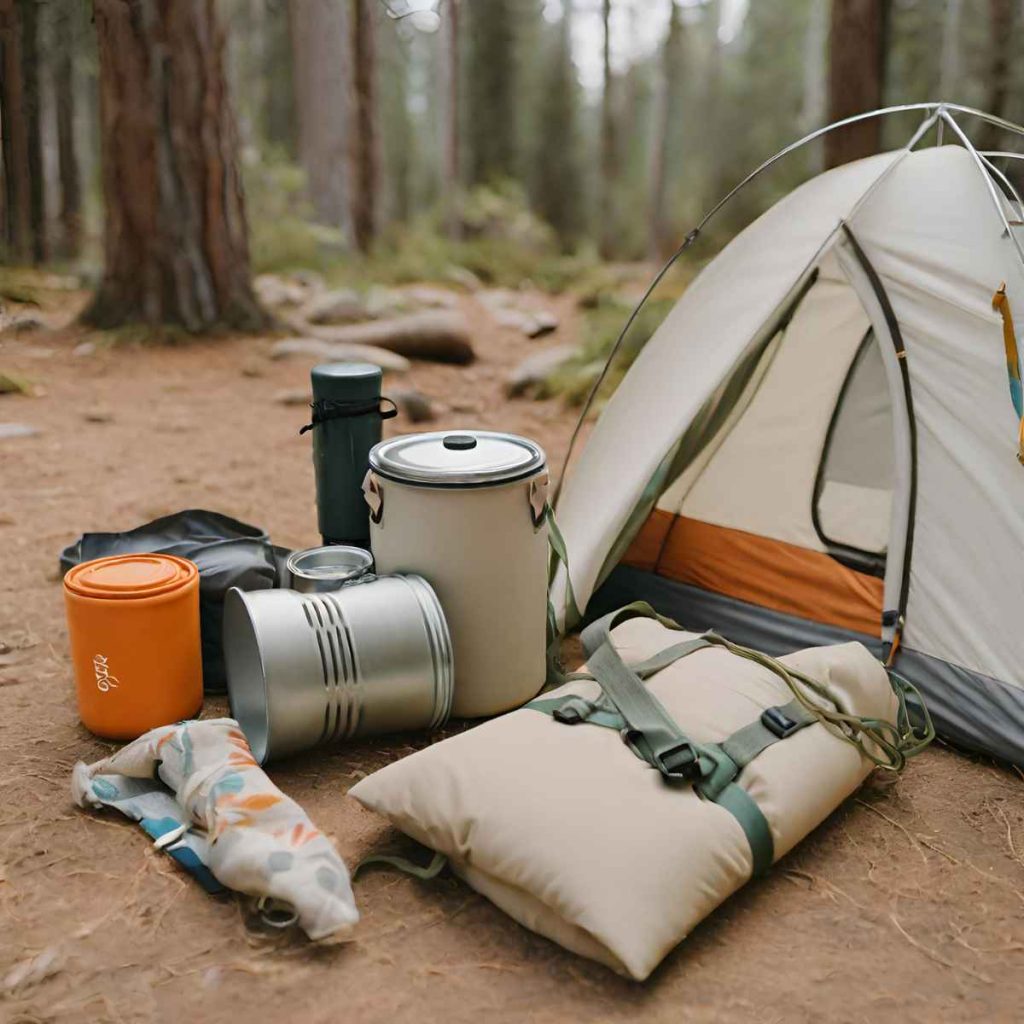
Benefits of Sleeping in a Non Toxic Tent
Choosing a non-toxic tent have a number of health and environmental benefits. Here are some key advantages:
- Reduces Your Exposure to Chemicals: Choosing a non-toxic tent reduces exposure to harmful chemicals, like flame retardant chemicals and volatile organic compounds (VOCs). As reported by the Minnesota Pollution Control Agency, VOC compounds are linked with health issues, including breathing difficulties, skin irritation, and effects on the nervous and reproductive systems.
- Improves Air Quality Inside the Tent: Choosing a non-toxic tent can help you avoid the strong chemical smell that can sometimes happens in tents, called “off-gassing.” This improves the breathability and airflow inside your tent.
- Minimizes Environmental Effects: Non-toxic tents are constructed with sustainable materials, including recycled polyester and canvas. They also contain as few toxic chemicals as possible, making the manufacturing process less damaging to the soil and groundwater.
- Increase Your Peace of Mind: Choosing a non-toxic tent demonstrates that you’ve made the decision to prioritize your health and the environment. It’s a real-world step towards a more sustainable camping experience.
History of Fire-Retardant Chemicals in Tents
In 1976, the U.S. government passed the “Toxic Substances Control Act“. Ironically, instead of banning dangerous chemicals as the name would imply, these rules required tents to have special flame retardant chemicals.
The goal was to reduce the chance of tents catching fire and to keep campers safe. This was a big deal at the time because circus tents were covered in paraffin, which is highly flammable.
These fire safety rules, which were helpful about 40 years ago, haven’t really changed over time. It’s a bit like still using a cassette player when everyone’s streaming music on Spotify.
In the past, tents were made from materials that could easily catch fire, but these days, thanks to the progress in material science, tents are much less likely to do so.
Yet, the old safety rules still apply, which means modern tents are often treated with the same fire-resistant chemicals as before.
Why Do Tents Contain Flame-Retardants?
Flame retardants are used to keep combustible materials from spreading. Regulations for these chemicals in tents stretch back to the 1970s, when they were put in place to safeguard fires from paraffin-treated canvas event tents used at circuses and fairs.
However, most people no longer use these type of old fashioned tents. Tent regulations haven’t been revised since the 1990’s, even though outdoor gear technology has evolved significantly.
In addition, flame retardants do not degrade easily, and can persist in the environment for years. These substances can also build up in the biological systems of people and animals over time.
What are the Most Common Types of Flame-Retardant Chemicals?
These come in a large number of variations and are frequently classified according to whether they contain bromine, chlorine, phosphorus, nitrogen, metals, or boron.
- Brominated FR chemical (BFRs): Often found in electronics, furniture, and building materials. BFRs can cause endocrine disruption and other health effects in humans.
- Organophosphates FR chemical (OPFRs): Most commonly found in camping tents, long-term exposure to OPFRs can cause a number of health effects, including neurological problems, depression, headaches, diarrhea, and nausea.
- Tetrabromobisphenol A FR chemical (TBBPAs): Typically used to make computer electronics, TBBPAs can cause toxicity in reproductive organs and the brain, and disruption of the endocrine system.
- Polybrominated diphenyl ethers FR chemical (PBDEs): Commonly found in furniture and electronics and easily inhaled in the air and dust. PBDEs may reduce infant birth weight, as well as impact brain development. US manufacturers of these chemicals voluntarily stopped making and importing them in 2004 and 2009. The FDA created a rule in 2012 to completely stop the importation of PBDEs.
- Hexabromocyclododecane FR chemical (HBCDs): Often found in foam products, HBCDs can have negative reproductive, developmental and neurological health effects in humans.
Health Statistics on Fire Retardant Chemicals
- According to the non-profit Eco Center, exposure to FR chemicals have been linked to health problems, including neurological, reproductive, and immune system effects.
- According to the EPA, flame retardant chemicals can leach out of products over time and accumulate in dust and air, increasing exposure to people and wildlife.
- The World Health Organization has identified several flame retardant chemicals, including polybrominated diphenyl ethers (PBDEs), as persistent organic pollutants that can pose a threat to human health and the environment.
2016 Duke University Study on Flame Retardants in Backpacking Tents
In a 2016 report by Duke University, “Characterizing Flame Retardant Applications and Potential Human Exposure in Tents”, scientists revealed that humans interact with significant amounts of flame retardants when they use backpacking tents.
“The researchers tested the air space inside 15 different tents for a set of known flame retardants. Based on their measurements, the researchers estimated that campers sleeping for eight hours inside the tents could potentially inhale compound levels ranging from a few nano-grams per kilogram of bodyweight to 400 nanograms per kilogram of bodyweight.”
Genna Gomes, a doctoral student at Duke and principal author of the research paper Characterizing Flame Retardant Applications and Potential Human Exposure in Backpacking Tents, sought to determine if flame retardant chemicals inhaled while camping could be absorbed into the body.
Twenty volunteers were asked to to erect tents made in 2014 and tested to contain organophosphate flame retardants (OPFRs). All the tents used in the study fulfilled the CPAI-84 flame resistance standard.
The participants’ hands were swabbed by the researchers before and after they put up the tents, and each swab was analyzed for OPFRs. They evaluated each tent for four different OPFRs before having volunteers put the tents together.
After erecting the tents, the volunteers had significantly more OPFRs on their hands than before, in some instances up to 29 times more of one particular chemical, TDCIPP.
While the quantities of OPFR chemicals found were very small – millionths to hundred-millionths of a gram – consistent exposure can cause these chemicals to accumulate in the body over time.
Children in particular appear to absorb these chemicals more readily because they tend to be more tactile, frequently touching surfaces and other objects.
The study was published in Environmental Science & Technology, “Characterizing Flame Retardant Applications and Potential Human Exposure in Tents.”
Eco-Friendly Certifications
TABLE 1: Certifications
| Certification Name | Key Criteria | Description |
|---|---|---|
| Global Organic Textile Standard (GOTS) | Prohibits the use of certain substances, including chemical flame retardants and limits on the emission of harmful chemicals such as formaldehyde and other volatile organic compounds (VOCs), as well as a variety of hazardous chemicals, pesticides, phthalates, lead, arsenic, and other heavy metals. Lays out percentage requirements for how much of a product must be certified organic. | GOTS is a certification standard for textiles that ensures products are produced without harmful chemicals and with minimal impact on the environment. |
| OEKO-TEX Standard 100 | Limits the levels of chemicals allowed in certified products depending on what type of product it is. Certain flame retardant chemicals are not allowed. | OEKO-TEX Standard 100 is a certification standard for textiles that ensures products are free of harmful substances and safe for human use. |
| REACH | Requires companies to register and report information on the use of chemicals in their products. Restricts the use of certain hazardous chemicals. | REACH is a European Union regulation that aims to protect human health and the environment from the risks posed by chemicals. |
| Bluesign | Ensures that products are produced with minimal impact on people and the environment. Limits the use of harmful substances in production processes4. | Bluesign is a certification standard for textiles that ensures products are produced sustainably and with minimal impact on the environment. |
| GreenGuard Gold | Limits emissions of volatile organic compounds (VOCs) from products to improve indoor air quality5. | GreenGuard Gold is a certification standard for indoor air quality that ensures products emit low levels of harmful chemicals. |
Tent Materials, Toxicity and Environmental Impact
TABLE 2: Common Tent Materials, Toxicity and Environmental Impact
| Material | Toxicity | Environmental Impact |
|---|---|---|
| Polyester | Can contain harmful chemicals such as phthalates and PFCs used in waterproofing treatments, which can have severe consequences for health and the environment. | Polyester is a synthetic material made from petroleum, which is not biodegradable and contributes to pollution. However, some companies are using recycled polyester to reduce environmental impact |
| Nylon | Can contain harmful chemicals such as PFCs used in waterproofing treatments. | Nylon is a synthetic material made from petroleum, which is not biodegradable and contributes to pollution. However, some companies are using recycled nylon to reduce environmental impact |
| Canvas | Canvas is a natural material made from cotton or hemp, which is less toxic than synthetic materials. However, it can still contain harmful chemicals such as pesticides and fungicides used in farming. | Cotton farming requires a lot of water and pesticides, which can have negative environmental impacts. Hemp is more sustainable than cotton because it requires less water and pesticides |
| Organic Cotton | Organic cotton is grown without the use of harmful pesticides and fertilizers, making it less toxic than conventional cotton. | Cotton farming requires a lot of water and pesticides, which can have negative environmental impacts. However, organic cotton farming is more sustainable than conventional cotton farming because it uses less water and does not use harmful chemicals |
| Hemp | Hemp is a natural material that is less toxic than synthetic materials. It is grown without the use of harmful pesticides and fertilizers, making it more sustainable than conventional cotton. | Hemp requires less water and pesticides than cotton, making it more sustainable than cotton |
| Eco-Friendly Alternatives | Some companies are using eco-friendly alternatives such as recycled polyester and nylon, organic cotton, and hemp to reduce environmental impact and toxicity levels. | Eco-friendly alternatives are more sustainable than conventional materials because they use fewer resources and do not contain harmful chemicals |
2016 Duke University Study on Flame Retardants in Backpacking Tents
A 2016 report conducted by Duke University scientists revealed that humans interact with significant amounts of flame retardants when they use backpacking tents.
Genna Gomes, a doctoral student at Duke and principal author of the research paper Characterizing Flame Retardant Applications and Potential Human Exposure in Backpacking Tents, sought to determine if flame retardant chemicals inhaled while camping could be absorbed into the body.
Twenty volunteers were asked to to erect tents made in 2014 and tested to contain organophosphate flame retardants (OPFRs). All the tents used in the study fulfilled the CPAI-84 flame resistance standard.
The participants’ hands were swabbed by the researchers before and after they put up the tents, and each swab was analyzed for OPFRs. They evaluated each tent for four different OPFRs before having volunteers put the tents together.
After erecting the tents, the volunteers had significantly more OPFRs on their hands than before, in some instances up to 29 times more of one particular chemical, TDCIPP.
While the quantities of OPFR chemicals found were very small – millionths to hundred-millionths of a gram – consistent exposure can cause these chemicals to accumulate in the body over time.
Children in particular appear to absorb these chemicals more readily because they tend to be more tactile, frequently touching surfaces and other objects.
“The researchers tested the air space inside 15 different tents for a set of known flame retardants. Based on their measurements, the researchers estimated that campers sleeping for eight hours inside the tents could potentially inhale compound levels ranging from a few nano-grams per kilogram of bodyweight to 400 nanograms per kilogram of bodyweight.”
The study was published in Environmental Science & Technology, “Characterizing Flame Retardant Applications and Potential Human Exposure in Tents.”
Health statistics on fire retardant chemicals
- Exposure to flame retardant chemicals has been linked to various health problems, including developmental delays, reduced IQ, hormone disruption, and cancer.
- A review of the scientific literature on flame retardants concluded that they can have “serious environmental and health impacts,” including neurological, reproductive, and immune system effects.
- Flame retardant chemicals can leach out of products over time and accumulate in dust and air, increasing exposure to people and wildlife.
- The World Health Organization has identified several flame retardant chemicals, including polybrominated diphenyl ethers (PBDEs), as persistent organic pollutants that can pose a threat to human health and the environment.
Non Toxic Tent FAQs
What are the most popular features of the North Face Stormbreak?
According to Reddit users, the best features of the Stormbreak are its durable construction, roomy interior, and easy setup process, with only 2 poles to support the entire shelter.
What are the most common complaints about the North Face Stormbreak?
The most common customer complaints about the Stormbreak 3 person tent are condensation buildup inside the tent, zipper malfunctions, and weight for backpackers who want a truly lightweight option for this tent.
What are the most common complaints about the Big Agnes Bunk House 6P?
Common complaints on about the BA Bunk House are the fact that despite technically being a 6 person tent, it comfortably fits about 4 adults, it has less vestibule space compared to tents like the Marmot Halo, and it’s pricier than similar other options in this capacity range. Also, this tent is heavier and bulkier, making it harder to transport and more time consuming to setup.
What are the most popular features of the Big Agnes Bunk House 6P?
Big Agnes campers love the Bunk House for its spacious layout, fast-fly rainfly that doubles as a shaded enclosure, high peak height of 80 inches, bonus features like a welcome mat and backpacks straps for easier transport.
What are the most common complaints about the North Face Wawona 6?
The customer complaints about the Wawona 6 tent are that the rainfly only partially covers half the tent, which could lead to leaks in rainy weather, the mesh only door between the vestibule and sleeping area doesn’t give campers privacy, the vestibule floor doesn’t have a very thick layer, and the zipper design that is prone to binding with the fabric if unzipped quickly with one hand.
What are the most popular features of the North Face Wawona 6?
Customers love the Wawona 6’s super spacious interior and roomy vestibules – these features add a sense of luxury and comfort because campers can really sprawl out.
Why should you buy a non toxic tent?
The health risk of fire retardants may significantly outweigh the protection they offer. The health effects of these chemicals may include kidney and liver cancers, neurological damage, respiratory illnesses, reproductive toxicity and fetal development.
What are flame-retardants?
The term “flame retardants” , also known as “fr chemicals”, refers to a family of chemicals added to flammable materials to prevent or delay the spread of fire. These chemicals are added to fabric in different parts of the tent, including the rainfly, canopy and floor.
Why are flame retardants dangerous?
The health risk of flame retardants may include kidney and liver cancers, neurological damage, respiratory illnesses, reproductive toxicity and fetal development problems. US states like Massachusetts, Maine and New Hampshire have started banning specific FR chemicals. Several flame retardants have been completely banned in Europe, and a larger ban of chemicals in the EU was done in 2022.
Which certifications should non-toxic tents have?
Non-toxic tents should have safety and environmental certifications like MADE SAFE, Forest Stewardship Council Certification, OEKO-TEX, Environmental Working Group (EWG), bluesign, UL GREENGUARD, and Design for the Environment (DfE).
Do flame retardants stop a tent from becoming flammable?
Flame retardants DO NOT stop a tent from becoming flammable. Regardless of whether they have been sprayed with a fire retardant chemical, all tents exposed to an open flame will burn. No such thing as a fireproof tent exists.
What steps are taken to minimize off-gassing from materials used in non-toxic tents?
Off-gassing is the process of releasing volatile organic compounds (VOCs) into the air from everyday products. To minimize off-gassing from materials used in non-toxic tents, it is recommended to choose materials that are low in volatile organic compounds (VOCs).
Why do tents have Prop 65 warning?
“Proposition 65”, also known as the Safe Drinking Water and Toxic Enforcement Act of 1986, is a California law that requires a warning on products that contain specific toxic chemicals, like flame retardants. Tents made with fire retardants (which are actually banned in the state of California) are required to have a Prop 65 label.
Are non-toxic tents easy to recycle?
Some tent materials like nylon or polyester can be recycled. However, tents with mixed-materials or silicone may not be recyclable. You also have the option of giving an old tent away to non profits like Tents4Homeless, and Teens to Trails.
Additional Information, Studies, Resources on Non Toxic Tents
- A Review of a Class of Emerging Contaminants: The Classification, Distribution, Intensity of Consumption, Synthesis Routes, Environmental Effects and Expectation of Pollution Abatement to Organophosphate Flame Retardants (OPFRs)
- Research on Per- and Polyfluoroalkyl Substances (PFAS), Environmental Protection Agency https://www.epa.gov/chemical-research/research-and-polyfluoroalkyl-substances-pfas
- Basic Facts about Mold and Dampness, Centers for Disease Control and Prevention https://www.cdc.gov/mold/faqs.htm
- Multiple Chemical Sensitivity, John Hopkins University: https://www.hopkinsmedicine.org/health/conditions-and-diseases/multiple-chemical-sensitivity
- Environmental Working Group (EWG): EWG is a reputable organization that provides research and resources on environmental health, including information on toxic chemicals and their impact on human health and the environment.
- National Institute of Environmental Health Sciences (NIEHS): NIEHS is a part of the National Institutes of Health (NIH) and focuses on researching environmental factors that affect human health. They provide valuable information on the health effects of toxic chemicals, including flame retardants and phthalates.
- Green Seal: Green Seal is a certification organization that sets environmental standards for various products, including camping gear. Their website provides information on eco-friendly and non-toxic products, including tents.
Related Camping Tent Posts:
- The best 4-person non-toxic tents for camping without flame retardants
- The best 8-person non-toxic tents without toxic flame retardants
- The best waterproof tents made without harmful flame retardants
- The best sustainable tents made from recycled materials
- How are Tents Made? A Step-by-Step Guide
- Ultralight Tents Under 3 Pounds
- NEMO Aurora VS North Face Wawona
- NEMO Hornet VS NEMO Dragonfly: What’s the Difference?
- Ultralight Tent Features: What You Need to Know Before You Buy
- How to choose a cold weather tent – a comprehensive guide
Related Outdoog Gear Guides
- A Guide to the Best Yosemite Backpacking Trails
- Best Backpacking in Colorado: 14 Scenic Trips Worth Exploring
- The Ultimate Guide to Backpacking
- The Best California Backpacking Trips for Adventure Junkies
- Best Backpacking Trails in the US
Sources:
- https://www.ecocenter.org/new-childrens-car-seat-report-shows-outdated-federal-flammability-standard-unnecessarily-exposes
- https://www.chemicalsafetyfacts.org/chemicals/flame-retardants/
- https://us.alpkit.com/blogs/develop/fire-retardants-in-tents
- https://www.canvascampingtents.com/Prop-65-Warning_ep_78-1.html
The North Face Stormbreak
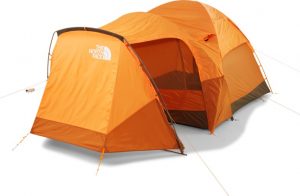
The North Face Stormbreak 3 Tent is a 3-season shelter, perfect for both backpacking and car camping. One of the best features of this tent is its lightweight design - it only weighs about 5 lbs! This easy-to-pitch, double-wall tent features no-see-um mesh for cool breathability, two doors and vestibules, and offers excellent airflow and internal space. The tent fabric is made with 68D polyester taffeta for the fly and floor, a 1500mm PU-coating, along with a breathable 75D polyester taffeta canopy. The freestanding structure is supported by two poles for fast, easy setup. Its minimum trail weight is 5lbs. 5 oz., with a fast-pitch option of 4lbs 5oz for lighter travel. The interior dimension are floor width and length of 88 x 65 inches, 46in interior height, and two 10.83 sq ft vestibules for gear storage.
Product Brand: The North Face
4.6
Pros
- Durability: Users report that the Stormbreak tent is durable and able to withstand various weather conditions, including rain, snow, and wind.
- Spacious Interior: The tent offers vertical walls inside, providing more space and making it feel roomier, especially when sitting up.
- Relatively Affordable: Compared to some other options, the Stormbreak is reasonably priced, making it accessible for those on a budget.
- Easy Maintenance: Users mention that the tent requires minimal maintenance, such as lubricating the zippers, to keep it in good shape.
Cons
- Limited Vestibule Coverage: The rain fly vestibule doesn't fully cover the ground, leading to rain potentially bouncing up and entering the tent during heavy rainfall.
- Limited Features: The tent lacks certain features found in higher-end models, such as multiple vestibules, extensive interior storage options, and a footprint included in the purchase.
Big Agnes Bunk House 6P

The Big Agnes Bunk House 6P is a spacious and versatile three-season tent, ideal for family or group camping adventures. Weighing in at 19 lbs 12 oz, it strikes a balance between portability and space, offering 83 sq ft of floor area and a peak height of 81 inches for ample room and comfort. Its sturdy construction includes a polyester taffeta rainfly and floor with a 1500mm waterproof polyurethane coating, ensuring durability and protection against the elements. The tent features two large doors for easy access, complemented by two vestibules for additional storage, including an oversized, pole-supported front vestibule that doubles as an awning for shaded relaxation. Airflow is maximized through the mesh roof and side panels, enhancing ventilation and reducing condensation. For convenience, the tent includes a welcome mat for cleanliness, pre-cut guylines for stability, and multiple interior pockets for organization. Despite its impressive size, the Bunk House 6P remains easy to set up, thanks to color-coded webbing and poles, and offers a Shelter Mode setup option for creating an open-air shelter on sunny days. The tent is also equipped with storm flaps on vestibule zippers for added weather protection and comes with a backpack-style carry bag for transportation and storage. Noteworthy accessories like the Bunk House 6 Footprint and Tarp Poles can be purchased separately to enhance the camping experience.
Product Brand: Big Agnes
4.4
Pros
- Spacious design, suitable for accommodating tall adults and small children comfortably.
- Versatile rainfly and poles that double as a shaded enclosure.
- High peak height (80 inches) providing ample headroom.
- Additional features like a welcome mat and backpack straps for convenience.
Cons
- Despite being labeled as a 6-person tent, it may realistically accommodate fewer people comfortably, likely closer to 4 individuals or a couple with small children.
- Limited vestibule space compared to other tents like the Marmot Halo, which may impact storage options.
- Potentially higher price point compared to other options, though discounts may be available.
The North Face Wawona 6

The North Face Wawona 6 is a versatile, 6-person, 3-season tent designed for families and groups seeking outdoor adventures with comfort and ease. Weighing approximately 21 pounds, this spacious tent boasts a peak height of 77 inches, ensuring most campers can stand upright in the center. The Wawona 6 differentiates itself with a large, integrated vestibule, offering 76 square feet of additional storage space, perfect for gear or as an extended living area. The tent's setup is streamlined thanks to color-coded poles and an intuitive clip-in canopy system, with a setup time that can be reduced to about 10 minutes after some practice. Durability is a key focus, featuring upgraded DAC MX tent poles and a robust 150D polyester floor. Comfort is enhanced by large mesh windows for optimal airflow and multiple internal storage pockets for organization. Despite its size, the single-wall design simplifies the setup process, eliminating the need for an additional rainfly. This design, coupled with the tent’s materials, offers solid weather resistance, making it a reliable shelter in various conditions
Product Brand: The North Face
4.2
Pros
- Spacious: Can accommodate 2 adults + 2 children or a dog comfortably, or 3-4 adults.
- Good ventilation: Features large window vents and options for airflow, suitable for warmer weather.
- Durable materials: Seams, zippers, and poles are sturdy, with no reported issues of leaks, snags, or tears.
- Large vestibule: Provides extra covered space, useful during rainy weather.
- Easy setup: Fairly straightforward to set up, especially with two people.
- Lifetime warranty: The North Face offers a lifetime warranty on their products, allowing for repairs or replacement in case of issues.
Cons
- Limited insulation: Not suitable for very cold weather or heavy snow, although it can handle temperatures down to freezing.
- Ventilation issues in hot weather: Airflow may be inadequate during hot summers, requiring additional measures like a battery-powered fan.
- Design flaw with the fly: The fly only covers half of the tent, potentially leading to issues in heavy rain.
- Vestibule door design: The opening between the vestibule and sleeping area only has a screen door, lacking privacy and requiring going outside to close outer doors for privacy.
- Poles may require effort to set up: Some users reported difficulty in inserting poles into the grommets, especially initially.
- Bulky and heavy: Not suitable for backpacking due to its large size and weight, primarily designed for car camping.


